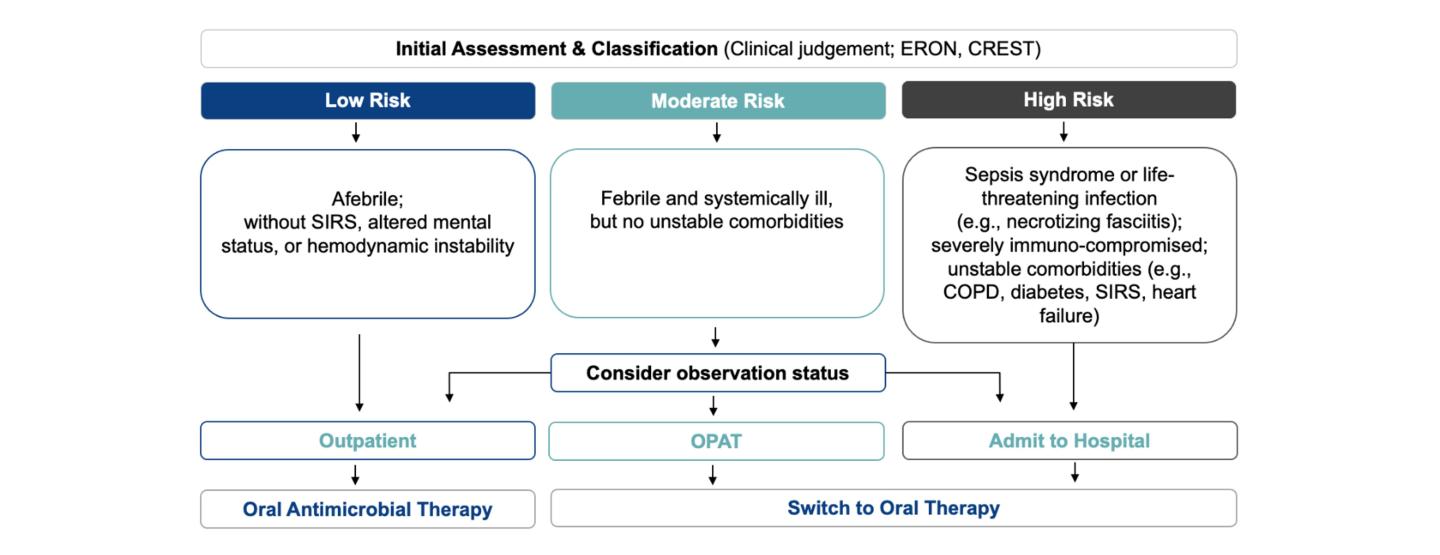Non-Purulent Infections
For patients with mild to moderate non-purulent infections, empiric treatment with an antibiotic with activity against streptococci is recommended. Patients with severe infections should receive broad-spectrum antibiotics along with surgical evaluation for necrotizing infection.3
Non-Purulent Infections (Cellulitis, Erysipelas, Necrotizing Infection) |
|---|
| | Recommended Treatment Regimen |
|---|
| Mild disease | - Empiric oral treatment with penicillin VK or a cephalosporin or dicloxacillin or clindamycin
|
| Moderate disease | - Empiric intravenous treatment with penicillin or ceftriaxone or cefazolin or clindamycin
|
| Severe disease | - Emergent surgical inspection and debridement to rule out necrotizing process
- Empiric vancomycin + piperacillin/tazobactam or imipenem/cilastin or meropenem
|
Purulent Infections
For mild purulent infections, incision and drainage is indicated. For patients with moderate to severe purulent infections empiric treatment with an antibiotic with activity versus Methicillin-sensitive Staphylococcus aureus (MSSA) is recommended. Empiric antibiotic may be adjusted based on culture and sensitivity results especially if MSSA is isolated.3
Purulent Infections (Furuncle, Carbuncle, Abscess, Wound) |
|---|
| | Recommended Treatment Regimens |
|---|
| Mild disease | - Incision and drainage only
|
| Moderate disease | - Incision and drainage plus culture and sensitivity
- Empiric oral treatment with trimethoprim/sulfamethoxazole or doxycycline
- If MSSA isolated may transition to dicloxacillin or cephalexin
|
| Severe disease | - Incision and drainage plus culture and sensitivity
- Empiric intravenous treatment with vancomycin or daptomycin or linezolid or telavancin or ceftaroline
- If MSSA isolated may transition to nafcillin or cefazolin or clindamycin
|
The choice of antibiotic is in influenced by infection type and likely pathogens, local resistance patterns and patient characteristics.1-3 Important infection characteristics and patient conditions such as site of infection, allergy history, and renal or hepatic impairment should also inform the antibiotic choice and dosing. The choice of antibiotics should also seek to minimize the potential for treatment-related toxicities and collateral damage including Clostridioides difficile infection.3,8,9,10
The 2014 IDSA guideline for SSTIs predates the FDA approval of several newer antibiotics for the treatment of SSTI, which may offer alternatives in treating resistant organisms.3,11,12
The 2020 Surgical Infection Society Guideline recommends newer oral antibiotics as potential alternative treatment options for suspected or confirmed MRSA in complicated SSTIs including ABSSSI.13

